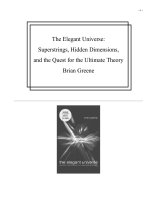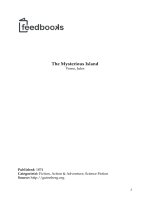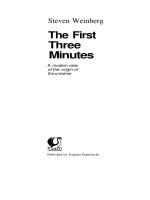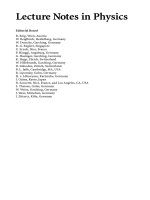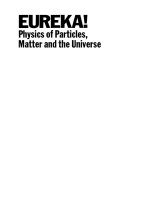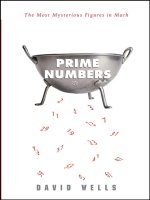The mysterious universe
Bạn đang xem bản rút gọn của tài liệu. Xem và tải ngay bản đầy đủ của tài liệu tại đây (2.74 MB, 158 trang )
Mathematical Sciences
From its pre-historic roots in simple counting to the algorithms powering
modern desktop computers, from the genius of Archimedes to the genius of
Einstein, advances in mathematical understanding and numerical techniques
have been directly responsible for creating the modern world as we know
it. is series will provide a library of the most inuential publications and
writers on mathematics in its broadest sense. As such, it will show not only
the deep roots from which modern science and technology have grown, but
also the astonishing breadth of application of mathematical techniques in the
humanities and social sciences, and in everyday life.
e Mysterious Universe
Originating from the Rede Lecture delivered at the University of Cambridge
in November 1930, this book is based upon the conviction that the teachings
and ndings of astronomy and physical science are destined to produce
an immense change on our outlook on the universe as a whole, and on
views about the signicance of human life. e author contends that the
questions at issue are ultimately one for philosophical discussion, but that
before philosophers can speak, science should present ascertained facts and
provisional hypotheses. e book is therefore written with these thoughts in
mind while broadly presenting the fundamental physical ideas and ndings
relevant for a wider philosophical inquiry.
C a m b r i d g e L i b r a r y C o L L e C t i o n
Books of enduring scholarly value
Cambridge University Press has long been a pioneer in the reissuing of
out-of-print titles from its own backlist, producing digital reprints of
books that are still sought aer by scholars and students but could not be
reprinted economically using traditional technology. e Cambridge Library
Collection extends this activity to a wider range of books which are still of
importance to researchers and professionals, either for the source material
they contain, or as landmarks in the history of their academic discipline.
Drawing from the world-renowned collections in the Cambridge
University Library, and guided by the advice of experts in each subject area,
Cambridge University Press is using state-of-the-art scanning machines
in its own Printing House to capture the content of each book selected for
inclusion. e les are processed to give a consistently clear, crisp image,
and the books nished to the high quality standard for which the Press
is recognised around the world. e latest print-on-demand technology
ensures that the books will remain available indenitely, and that orders for
single or multiple copies can quickly be supplied.
e Cambridge Library Collection will bring back to life books of enduring
scholarly value (including out-of-copyright works originally issued by other
publishers) across a wide range of disciplines in the humanities and social
sciences and in science and technology.
e Mysterious
Universe
J J
CAMBRIDGE U N I V ERSITY PRES S
Cambridge, New York, Melbourne, Madrid, Cape Town, Singapore,
São Paolo, Delhi, Dubai, Tokyo
Published in the United States of America by Cambridge University Press, New York
www.cambridge.org
Information on this title: www.cambridge.org/9781108005661
© in this compilation Cambridge University Press 2009
is edition rst published 1930
is digitally printed version 2009
ISBN 978-1-108-00566-1
is book reproduces the text of the original edition. e content and language reect
the beliefs, practices and terminology of their time, and have not been updated.
Cambridge University Press wishes to make clear that the reissue of out-of-copyright
books not originally published by Cambridge does not imply any knowledge
or advocacy of the reissue project on the part of the original publisher.
THE MYSTERIOUS UNIVERSE
I.
THE DEPTHS OF SPACE
A Cluster
of
Nebulae
in
Coma
Berenices.
This is
a
photograph
of a
minute
piece of the sky, taken with the largest telescope in existence (Mount Wilson,
100-inch). The majority of objects are nebulae,
at a
distance such that their
light takes 50 million years to reach us. Each nebula contains some thousands
of millions
of
stars, or the material for their formation. About two million
such nebulae can be photographed in all, and there are probably millions of
millions of others beyond the range of any telescope (see p. 57)
THE
MYSTERIOUS
UNIVERSE
by
SIR JAMES JEANS
O.M., F.R.S.
CAMBRIDGE
AT
THE
UNIVERSITY PRESS
1948
CAMBRIDGE UNIVERSITY PRESS
Cambridge, New York, Melbourne, Madrid, Cape Town, Singapore, Sao Paulo, Delhi
Cambridge University Press
The Edinburgh Building, Cambridge CB2 8RU, UK
Published in the United States of America by Cambridge University Press, New York
www.cambridge.org
Information on this title: www.cambridge.org/9780521054171
© Cambridge University Press 1930
This publication is in copyright. Subject to statutory exception
and to the provisions of relevant collective licensing agreements,
no reproduction of any part may take place without the written
permission of Cambridge University Press.
First published 1930
Reprinted (with further corrections) 1930
Second edition 1931
Reprinted (with corrections) 1933
Reprinted 1948
This digitally printed version 2008
A catalogue record for this publication is available from the British Library
ISBN 978-0-521-05417-1 hardback
ISBN 978-0-521-09001-8 paperback
CONTENTS
Foreword page
vii
Chapters
I The Dying Sun 1
II The New World of Modern Physics 13
III Matter and Radiation 40
IV Relativity and the Ether 70
V Into the Deep Waters 101
Index
139
Plates
I The Depths of Space
frontispiece
II The Diffraction of Light and of
Electrons
facing page
37
And now, I
said,
let me show in a figure how far our nature is
enlightened or unenlightened:—Behold! human beings living in an
underground cave, which has a mouth open towards the light and
reaching all along the cave; here they have been from their
child-
hood,
and have their legs and necks chained so that they cannot
move, and can only see before them, being prevented by the chains
from turning round their heads. Above and behind them a fire
is blazing at a distance, and between the fire and the prisoners
there is a raised way; and you will
see,
if you
look,
a low wall built
along the way, like the screen which marionette players have in
front of them, over which they show the puppets.
I see.
And do you see, I
said,
men passing along the wall carrying all
sorts of vessels, and statues and figures of animals made of wood
and stone and various materials, which appear over the wall?
You have shown me a strange image, and they are strange
prisoners.
Like ourselves, I
replied;
and they
see
only their own shadows, or
the other shadows which the fire throws on the opposite wall of the
cave?
True, he
said;
how could they see anything but the shadows if
they were never allowed to move their heads?
And of the objects which are being carried in like manner they
would only see the shadows?
Yes,
he
said.
To them, I
said,
the truth would be literally nothing but the
shadows of the images.
PLATO,
Republic, Book VII
FOREWORD
The present book contains an expansion of the Rede
Lecture delivered before the University of Cambridge in
November 1930.
There is a widespread conviction that the new teachings
of astronomy and physical science are destined to produce
an immense change on our outlook on the universe as a
whole, and on our views as to the significance of human life.
The question at issue is ultimately one for philosophic
discussion, but before the philosophers have a right to
speak, science ought first to be asked to tell all she can as
to ascertained facts and provisional hypotheses. Then, and
then only, may discussion legitimately pass into the realms
of philosophy.
With some such thoughts as these in my mind, I wrote
the present book, obsessed by frequent doubts
as to
whether
I could justify an addition to the great amount which has
already been written on the subject. I can claim no special
qualifications beyond the proverbially advantageous posi-
tion of the mere onlooker; I am not a philosopher either
by training or inclination, and for many years my scientific
work has lain outside the arena of contending physical
theories.
The first four chapters, which form the main part of the
book, contain brief discussions, on very broad lines, of such
scientific questions as seem to me to be of interest, and to
provide useful material, for the discussion of the ultimate
philosophical problem. As far as possible I have avoided
overlapping my former book, The
Universe
Around Us,
V1U FOREWORD
because
I
hope the present book may be read as
a
sequel
to
that. But an exception has been made in favour of material
which is essential
to
the main argument, so as
to
make
the
present book complete
in
itself.
The last chapter stands
on a
different level. Every
one
may claim the right
to
draw his own conclusions from
the
facts presented
by
modern science. This chapter merely
contains
the
interpretations which
I, a
stranger
in the
realms of philosophical thought, feel inclined to place on the
scientific facts and hypotheses discussed in the main part of
the book. Many will disagree with it—it was written to this
end.
J. H. JEANS
DORKING,
1930
In preparing
a
second edition,
I
have tried
to
bring
the
scientific matter of the first four chapters up to date, and
to
remove
all
ambiguities from
my
argument.
I
found with
regret that certain
passages in
the original book were
liable
to
be misunderstood, misinterpreted,
and
even misquoted,
in
various unexpected ways. Some
of
these passages have
been expunged, some rewritten
and
some amplified. Here
and there new paragraphs, occasionally even whole pages,
have
been added
in
the
hope
of making the argument clearer.
J. H. JEANS
DORKING,
July
1st, 1931
Chapter I
THE DYING SUN
A few stars are known which are hardly bigger than the
earth, but the majority are so large that hundreds of
thousands of earths could be packed inside each and leave
room to spare; here and there we come upon a giant star
large enough to contain millions of millions of earths. And
the total number of stars in the universe is probably some-
thing like the total number of grains of sand on all the sea-
shores of the world. Such is the littleness of our home in
space when measured up against the total substance of the
universe.
This vast multitude of
stars are
wandering about
in
space.
A few form groups which journey in company, but the
majority are solitary travellers. And they travel through a
universe so spacious that it is an event of almost unimagin-
able rarity for a star to come anywhere near to another
star. For the most part each voyages in splendid isolation,
like a ship
on
an empty
ocean.
In a
scale
model in which the
stars are ships, the average ship will be well over a million
miles from its nearest neighbour, whence it
is
easy to under-
stand why a ship seldom finds another within hailing
distance.
We
believe, nevertheless, that some two thousand million
years ago this rare event took place, and that a second star,
wandering blindly through space, happened to come within
hailing distance of the sun. Just as the sun and moon raise
tides on the earth, so this second star must have raised tides
JMU I
2 THE
DYING
SUN
on the surface of the sun. But they would be very different
from the puny tides which the small mass of
the
moon raises
in our oceans; a huge tidal wave must have travelled over
the surface of the sun, ultimately forming a mountain of
prodigious height, which would rise ever higher and higher
as the cause of the disturbance came nearer and nearer.
And, before the second star began to recede, its tidal pull
had become so powerful that this mountain was torn to
pieces and threw off small fragments of
itself,
much as the
crest of a wave throws off spray. These small fragments have
been circulating around their parent sun ever since. They
are the planets, great and small, of which our earth is one.
The sun and the other stars we see in the sky are all
intensely hot—far too hot for life to be able to obtain or
retain a footing on them. So also no doubt were the ejected
fragments of the sun when they were first thrown off.
Gradually they cooled, until now they have but little in-
trinsic heat left, their warmth being derived almost entirely
from the radiation which the sun pours down upon them.
In course of time, we know not how, when, or why, one of
these cooling fragments gave birth to life. It started in
simple organisms whose vital capacities consisted of little
beyond reproduction and death. But from these humble
beginnings emerged a stream of life which, advancing
through ever greater and greater complexity,
has
culminated
in beings whose lives are largely centred in their emotions
and ambitions, their aesthetic appreciations, and the re-
ligions in which their highest hopes and noblest aspirations
lie enshrined.
Although we cannot speak with any certainty, it seems
most likely that humanity came into existence in some
such way as this. Standing on our microscopic fragment
THE
DYING
SUN 8
of a grain of sand, we attempt to discover the nature and
purpose of the universe which surrounds our home in space
and time. Our first impression is something akin to terror.
We
find the universe terrifying because of
its
vast meaning-
less distances, terrifying because of its inconceivably long
vistas of time which dwarf human history to the twinkling
of an eye, terrifying because of our extreme loneliness, and
because of the material insignificance of our home in space
—a millionth part of a grain of sand out of all the sea-
sand in the world. But above all else, we find the universe
terrifying because it appears to be indifferent to life like
our own; emotion, ambition and achievement, art and re-
ligion all seem equally foreign to its plan. Perhaps indeed
we ought to say it appears to be actively hostile to life
like our own. For the most part, empty space is so cold
that all life in it would be frozen; most of the matter in
space is so hot as to make life on it impossible; space is
traversed, and astronomical bodies continually bombarded,
by radiation of a variety of
kinds,
much of which
is
probably
inimical to, or even destructive of, life.
Into such a universe we have stumbled, if not exactly
by mistake, at least as the result of what may properly be
described as an accident. The use of such a word need not
imply any surprise that our earth exists, for accidents will
happen, and if the universe goes on for long enough, every
conceivable accident is likely to happen in time. It was, I
think, Huxley who said that six monkeys, set to strum
unintelligently on typewriters for millions of millions of
years,
would be bound in time to write all the books in the
British Museum. If we examined the last page which a
particular monkey had typed, and found that it had
chanced, in its blind strumming, to type a Shakespeare
4 THE
DYING
SUN
sonnet, we should rightly regard the occurrence as a re-
markable accident, but if
we
looked through all the millions
of pages the monkeys had turned off in untold millions of
years,
we might be sure of finding a Shakespeare sonnet
somewhere amongst them, the product of the blind play of
chance. In the same way, millions of millions of stars
wandering blindly through space for millions of millions of
years are bound to meet with every kind of accident; a
limited number are bound to meet with that special kind
of accident which calls planetary systems into being. Yet
calculation shews that the number of these can at most be
very small in comparison with the total number of stars in
the sky; planetary systems must
be
exceedingly rare obj ects
in space.
This rarity of planetary systems is important, because so
far as we can see, life of the kind we know on earth could
only originate on planets like the earth. It needs suitable
physical conditions for its appearance, the most important
of which is a temperature at which substances can exist in
the liquid state.
The stars themselves are disqualified by being far too hot.
We may think of them as a vast collection of fires scattered
throughout space, providing warmth in a climate which is
at most some four degrees above absolute zero—about 484
degrees of frost on our Fahrenheit scale—and is even lower
in the vast stretches of space which lie out beyond the
Milky Way. Away from the
fires
there is this unimaginable
cold of hundreds of degrees of frost; close up to them there
is a temperature of thousands of
degrees,
at which all solids
melt, all liquids boil.
Life can only exist inside a narrow temperate zone which
surrounds each of these fires at a very definite distance.
THE
DYING
SUN 5
Outside these zones life would be frozen; inside, it would be
shrivelled up. At a rough computation, these zones within
which life
is
possible, all added together, constitute
less
than
a thousand million millionth part of the whole of space.
And even inside them, life must be of very rare occurrence,
for it is so unusual an accident for suns to throw off planets
as our own sun has done, that probably only about one star
in 100,000 has a planet revolving round it in the small zone
in which life is possible.
Just for this reason it seems incredible that the universe
can have been designed primarily to produce life like our
own; had it been so, surely we might have expected to find
a better proportion between the magnitude of the mechan-
ism and the amount of the product. At first glance at least,
life seems to be an utterly unimportant by-product; we
living things are somehow off the main line.
We do not know whether suitable physical conditions are
sufficient in themselves to produce life. One school of
thought holds that as the earth gradually cooled, it was
natural, and indeed almost inevitable, that life should
come. Another holds that after one accident had brought
the earth into being, a second was necessary to produce life.
The material constituents of a living body are perfectly
ordinary chemical atoms—carbon, such as we find in soot
or lampblack; hydrogen and oxygen, such as we find in
water; nitrogen, such as forms the greater part of the
atmosphere; and so on. Every kind of atom necessary for
life must have existed on the new-born earth. At intervals,
a group of
atoms
might happen to arrange themselves in the
way in which they are arranged in the living cell. Indeed,
given sufficient time, they would be certain to do
so,
just as
certain as the six monkeys would be certain, given sufficient
6 THE DYING SUN
time,
to type off a Shakespeare sonnet. But would they
then be a living cell? In other words, is a living cell merely
a group of ordinary atoms arranged in some non-ordinary
way, or is it something more? Is it merely atoms, or is it
atoms plus life? Or, to put it in another way, could a
sufficiently skilful chemist create life out of the necessary
atoms, as a boy can create a machine out of " Meccano,"
and
then make
it go ? We do not know the
answer.
When it comes
it
will give us some
indication whether other
worlds
in space
are inhabited like ours, and so must have the greatest in-
fluence on our interpretation of the meaning of life—it may
well produce a greater revolution of thought than Galileo's
astronomy or Darwin's biology.
We do, however, know that while living matter consists
of quite ordinary atoms, it consists in the main of atoms
which have a special capacity for coagulating into extra-
ordinary large bunches or "molecules."
Most atoms do not possess this property. The atoms of
hydrogen and oxygen, for instance, may combine to form
molecules of hydrogen (H
2
or H
3
), of oxygen or ozone
(O
2
or O
3
), of water (H
2
O), or of hydrogen peroxide (H
2
O
2
),
but
none
of these compounds contains
more
than four atoms.
The addition of nitrogen does not greatly change the
situation; the compounds of hydrogen, oxygen and nitrogen
all contain comparatively few atoms. But the further
addition of carbon completely transforms the picture; the
atoms of
hydrogen,
oxygen, nitrogen
and carbon
combine to
form molecules containing hundreds, thousands, and even
tens of thousands, of atoms. It is of such molecules that
living bodies are mainly formed. Until a century ago it was
commonly supposed that some "vital force" was necessary
to produce these and the other substances which entered
THE
DYING
SUN 7
into the composition of the living body. Then Wohler
produced urea (CC^NH^), which is a typical animal pro-
duct,
in his
laboratory, by the ordinary
processes
of chemical
synthesis, and other constituents of the living body followed
in due
course.
To-day one phenomenon after another which
was at one time attributed to "vital force" is being traced
to the action of the ordinary processes of physics and
chemistry. Although the problem is still far from solution,
it is becoming increasingly likely that what specially distin-
guishes the matter of living bodies is the presence not of a
" vital
force,"
but of the quite commonplace element carbon,
always in conjunction with other atoms with which it forms
exceptionally large molecules.
If this is so, life exists in the universe only because the
carbon atom possesses certain exceptional properties. Per-
haps carbon is rather noteworthy chemically as forming a
sort of transition between the metals and non-metals, but
so far nothing in the physical constitution of the carbon
atom is known to account for its very special capacity for
binding other atoms together. The carbon atom consists
of six electrons revolving around the appropriate central
nucleus, like six planets revolving around a central sun; it
appears to differ from its
two
nearest neighbours in the table
of chemical elements, the atoms of boron and nitrogen,
only in having one electron more than the former and one
electron fewer than the latter. Yet this slight difference
must account in the last resort for all the difference between
life and absence of life. No doubt the reason why the six
electron atom possesses these remarkable properties resides
somewhere in the ultimate
laws
of nature, but mathematical
physics has not yet fathomed it.
Other similar cases are known to chemistry. Magnetic
8 THE
DYING
SUN
phenomena appear in a tremendous degree in iron, and in a
lesser degree in its neighbours, nickel and cobalt. The atoms
of these elements have 26, 27 and 28 electrons respectively.
The magnetic properties of all other atoms are almost
negligible in comparison. Somehow, then, although again
mathematical physics has not yet unravelled how, mag-
netism depends on the peculiar properties of the 26, 27 and
28 electron atoms, especially the first. Radio-activity
provides a third instance, being confined, with insignificant
exceptions, to atoms having from 83 to 92 electrons; again
we do not know why.
Thus chemistry can only tell us to place life in the same
category as magnetism and radio-activity. The universe is
built so as to operate according to certain laws. As a
consequence of these laws, atoms having certain definite
numbers of
electrons,
namely
6,
26 to
28,
and
83
to
92,
have
certain special properties, which shew themselves in the
phenomena of life, magnetism and radio-activity re-
spectively.
An
omnipotent creator, subject to no limitations
whatever, would not have been restricted to the laws which
prevail in the present universe; he might have elected to
build the universe to conform to any one of innumerable
other sets of laws. If some other set of laws had been
chosen, other special atoms might have had other special
properties associated with them. We cannot say what, but
it seems a priori unlikely that either radio-activity or
magnetism or life would have figured amongst them.
Chemistry suggests that,
like
magnetism and radio-activity,
life may merely be an accidental consequence of the special
set of laws by which the present universe is governed.
Again the word "accidental" may be challenged. For
what if
the
creator of the universe selected one special set
of
THE
DYING
SUN 9
laws just because they led to the appearance of life? What
if this were his way of creating life? So long as we think of
the creator as a magnified man-like being, activated by
feelings and interests like our own, the challenge cannot be
met, except perhaps by the remark that, when such a
creator has once been postulated, no argument can add
much to what has already been assumed. If, however, we
dismiss every trace of anthropomorphism from our minds,
there remains no reason for supposing that the present laws
were specially selected in order to produce life. They are
just as likely, for instance, to have been selected in order to
produce magnetism or radio-activity—indeed more likely,
since to all appearances physics plays an incomparably
greater part in the universe than biology. Viewed from a
strictly material standpoint, the utter insignificance of life
would seem to go far towards dispelling any idea that it
forms a special interest of the Great Architect of the
universe.
A trivial analogy may exhibit the situation in a clearer
light. An unimaginative sailor, accustomed to tying knots,
might think it would
be
impossible to
cross
the ocean if tying
knots were impossible. Now the capacity for tying knots is
limited to space of three dimensions; no knot can be tied in
a space of 1, 2, 4, 5 or any other number of dimensions.
From this fact our unimaginative sailor might reason that
a beneficent creator must have had sailors under his special
patronage, and have chosen that space should have three
dimensions in order that tying knots and crossing the ocean
should be possibilities in the universe he had created—in
brief,
space was of three dimensions so that there could be
sailors. This and the argument outlined above seem to be
much on a level, because life as a whole and the tying of
10 THE DYING SUN
knots are pretty much on a level in that neither of them
forms more than an utterly insignificant fraction of the total
activity of the material universe.
So much for the surprising manner in which, so far as
science can at present inform us, we came into being. And
our bewilderment
is
only increased when
we
attempt to pass
from our origins to an understanding of the purpose of our
existence, or to foresee the destiny which fate has in store
for our race.
Life of the kind we know can only exist under suitable
conditions of light and heat;
we
only exist ourselves because
the earth receives exactly the right amount of radiation
from the sun; upset the balance in either direction, of
excess or defect, and life must disappear from the earth.
And the essence of the situation is that the balance is very
easily upset.
Primitive man, living in the temperate zone of the
earth, must have watched the ice-age descending on his
home with something like terror; each year the glaciers
came farther down into the valleys; each winter the sun
seemed less able to provide the warmth needed for life. To
him, as to us, the universe must have seemed hostile to
life.
We of these later days, living in the narrow temperate
zone surrounding our sun and peering into the far future,
see an ice-age of a different kind threatening us. Just as
Tantalus, standing in a lake so deep that he only just
escaped drowning, was yet destined to die of thirst, so it is
the tragedy of our race that it is probably destined to die
of cold, while the greater part of the substance of the
universe still remains too hot for life to obtain a footing.
The sun, having no extraneous supply of heat, must
